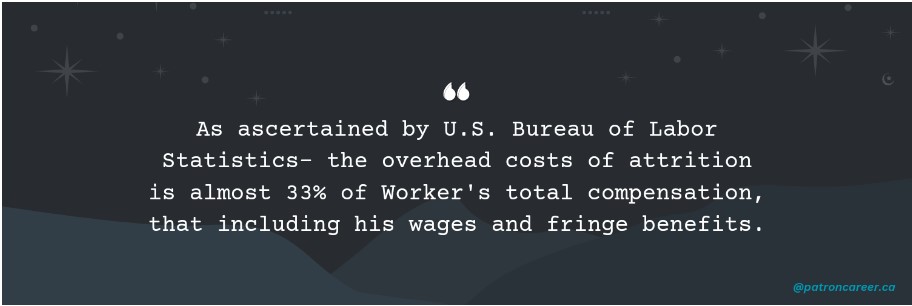
HR Leadership in Workplace
14 February, 2023
Patron Career Staffing firmly believes in adopting a tailored approach to meet temporary and permanent recruitment needs. We safeguard the interest of our clients by finding such workers who are knowledgeable and reliable.
About UsNeed help? Make a Call
32 Dundas Street East Unit A, L5A1W2

Employee turnover can be a major issue for many organizations, and it can have a detrimental impact on productivity, morale, and profitability. While some degree of turnover is natural and even healthy for organizations, excessive or unexpected employee departures can indicate underlying problems within the company. In this blog post, we will explore some of the most common reasons why employees leave organizations. Understanding these reasons will aid companies to address this burning issue and better retention.

1. A ‘Bossy’ Boss
Believe us or not but bad managers are often the topmost reason employees leave even the most well-paying jobs. The saying holds to date- employees don’t leave bad companies, they leave bad managers. Managers are disliked when they are not giving proper guidance, are not making smart goals for their teams, are low on empathy and emotional intelligence and fail to give useful feedback. So to improve employee retention, companies must focus on building a healthy bond between managers and their subordinates.
2. Poor Leadership and Management
One of the most common reasons employees leaves organizations is poor leadership and management. This can include a lack of clear communication, a failure to provide adequate resources and support, or micromanagement. Employees who do not feel valued, respected, or supported by their managers are much more likely to look for work elsewhere.
Also read: 5 Recruitment Challenges Common To All Organizations, And Remedies To Overcome Them
3. Limited Opportunities for Career Growth
Another reason employee leave jobs is limited opportunities for career growth and development. When employees feel that their potential for growth and advancement is limited within an organization, they may begin to look for opportunities elsewhere. This is particularly true for younger employees who have just stepped out with degrees and are keen to learn and grow in their specified areas. Companies should aim to provide quality assistance to new hires and regularly come up with interactive ways to instil training and education in all workforce through- seminars, lectures, coaching, vestibule training and so on.
Explore: Career Planning And Tips Guide
4. Deficiency in Salary, Compensation and Fringe Benefits
Compensation and benefits are also important monetary factors that play a toll on employee retention. When employees feel that they are not being paid fairly for their good work, or when they are not provided with sufficient benefits such as health insurance, retirement plans, or paid leaves, they may begin to look for other opportunities that offer better compensation and benefits. The solution to the problem of employee turnover is- a well-designed and maintained benefits plan that covers non-monetary incentives such as disability insurance, financial wellness programs, flexible working hours, PTO, worker's compensation, etc.
For a more detailed note on how to design and evaluate An Employee Benefits Program, click here!
5. Poor Work-Life Balance leading to Burnout
Employees who feel that they are always flooded out with tasks that too with little or no praise and recognition are more likely to leave an organization. This can also include working long hours, not having a flexible work schedule, or feeling that their personal life is being ignored or disrespected by their employer. Organizations that prioritize work-life balance and give employees some time off to recharge are much more likely to retain their employees for a longer period.

6. Toxic Workplace Culture
The overall corporate culture of a company also determines its retention rates and people management efficacy. When employees face constant bullying, harassment, indifference, or other forms of mistreatment and bias, they lose their eagerness to continue working in that company. A workplace culture that values diversity, inclusion, and respect is much more likely to retain its employees. But most importantly, companies must work towards addressing employees' grievances and take immediate action towards violation of company norms.
7. Lack of Recognition and Appreciation
Employees who feel that their work is not valued or appreciated by their employer are more likely to look for opportunities elsewhere. This can include a failure to provide adequate recognition, feedback, or opportunities for growth and development. Organizations that prioritize employee recognition and appreciation are much more likely to retain their employees.
8. Changes in the Company
Changes within the organization can also lead to employee turnover. This can be by way of- mergers, amalgamations, acquisitions, corporate restructuring, or leadership changes. Employees who feel uncertain about the future of the organization or who feel that their job security is at risk may begin to look for other opportunities.
9. Personal Reasons
Finally, it is important to remember that employees may leave an organization for professional and even personal reasons that are beyond the control of the employer. This can include health issues, feeling uninspired, family concerns, or a desire to relocate. While these reasons may not be preventable, employers can still work to create a supportive and understanding workplace culture that values its employees' welfare.
Wrap up…
In conclusion, employee turnover can be a major challenge for organizations, and employers need to understand the reasons why employees leave. By addressing these factors and creating a workplace culture that values employee engagement, organizations can ameliorate employee retention, boost productivity, and foster a more positive and efficient workforce.
For a company like PCS, which provides staffing solutions to employers and businesses all over the GTA, feedback is an integral part of our work. Whether it is formal, informal, external, or internal, giving and receiving feedback aids us in the improvement of our services and leads us toward greater success.
